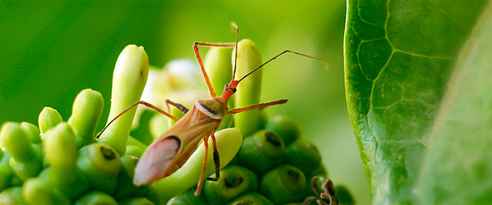
The wisdom of nature fascinates me. You need only take a walk in the outdoors to see why. At first glance, you may marvel at its beauty, but when you look closer, you’re sure to spot the elegant efficiency that is uniquely Mother Nature. Nothing is wasted. All is needed. Everything counts. To me, nature is a perfect place to find inspiration for sustainable solutions not only for healthy living, but for a healthy planet. So perfect, in fact, it has inspired a movement.

Sustainability inspired by nature
For eons, man has found solutions to problems big and small by watching, learning and modeling the wisdom of nature. Today, we’re watching even more closely to find sustainable solutions, thanks to the biomimicry movement. I like that.
Biomimicry, a term coined by naturalist Janine Benyus about 20 years ago, is now a mainstream movement. A growing number of researchers, architects, inventors and other creative types look to nature to inspire their own well-designed solutions. Each one starting with a simple question: “I have a problem, how would nature solve it?”

What exactly is biomimicry?
According to The Biomimicry Institute (yes, there is an institute), the goal of biomimicry is to find sustainable solutions to human challenges by emulating the patterns and strategies found in nature that have stood the test of time. The result is products, processes and policies that not only help us thrive, but protect the planet.[i]
The bur is a common example of biomimicry in action. These airborne specks of dry plants have hooks that can cling to clothes with impressive tenacity, much to the dismay of most hikers. But not to Swiss engineer George de Mestral, who took a closer look at the bur and was inspired to create the Velcro® hook-and-loop fastener, which he patented in the mid-1950s.
You may also recognize biomimicry in other products: bullet trains inspired by king fisher birds, houses modeled after baobab trees, air conditioning systems patterned after termite hills, or solar power systems inspired by leaves.
Nutrilite solutions powered by biomimicry
My father understood the wisdom of nature long before the biomimicry movement. As a young man traveling in China, he was intrigued by the shiny coats of cows grazing only on alfalfa and drinking water. He also noticed people in rural areas, who ate a diet rich in fruits, vegetables and whole grains, were healthier than their urban counterparts who consumed more refined foods. These types of observation eventually led to the creation of Nutrilite® brand supplements — a supplement inspired by nature.
Another Nutrilite example of biomimicry is the natural pesticide BIOTROL developed by scientists at Nutrilite Products, Inc., in the 1950s. They were looking for spotted aphids, dead ones in this case, that had been rampaging the alfalfa fields. They noticed some of the dead aphids were covered with a fuzz from mold. After testing, they found the mold spores could control the aphid problem and do so without the bugs developing a tolerance to the fungal material. This discovery didn’t result in a commercial product (spotted aphids are not a big pest), but it did inspire my father to find a way to naturally ward off certain destructive caterpillars. He hired entomologists, biologists and fermentation experts and eventually produced BIOTROL. It was derived from the bacteria Bacillus thuringiensis and considered the first natural biological pest control in the marketplace.

Good bugs, bad bugs and more
Finding inspiration in nature is a huge part of what Nutrilite scientists do. They use beneficial bugs – lady bugs, green lace wings and others – to balance harmful bugs. They rely on sheep droppings to feed earthworms, microbes and other organisms needed for rich, fertile soil. They closely monitor harvesting time to ensure optimal nutrient content in plants.
It is also important to look to nature to see what is suited for the land. For this reason, we source plant ingredients for Nutrilite® brand products from farms that have the right climate, soil and weather conditions for a particular crop, and why we partner with like-minded farmers around the world in our NutriCert™ Program.
Surround yourself with nature’s inspiration
We spend a lot of time at our home in Telluride, Colorado, but this year was the first time we were there to see the Aspen leaves changing color. It was an unbelievable sight, true living color in brilliant greens, translucent yellows and deep golds. These majestic trees paint a spectacular picture, but to me, they also offer inspiration for biomimicry of a cultural sort. You see, the Aspens are all connected by one massive root system that allows them to thrive, year after year, earning them the moniker of largest living organism on the planet. Imagine what we could accomplish for our planet if we could be as connected?

I encourage you to get outdoors as much as you can. Go somewhere that soothes your soul –walk along a beach, hike a mountain trail, sit in a city park or enjoy your own garden more. While there, look closer at the flowers, trees, shrubs and nature’s other wonders. Look for symmetry, check out the patterns, and find something you haven’t noticed before.
I believe the more we connect with nature, the more we open our minds to nature-inspired solutions and, most importantly, the lighter we will tread on our planet. Who’s ready for a nature walk?
Till next time!
![]()
P.S. Don’t forget you can subscribe to our RSS feed to have blog posts delivered right to your inbox.

I especially loved this blog. I enjoy the outdoors on many levels and will certainly take a closer look at my environment on my daily walks. On a side note, my recent trek along the Castaways in Newport Beach exuded unusual fragrances of this beautiful natural setting. I stopped often, not to smell the roses, but to take in the natural herbs. Thank you for this gentle reminder to appreciate all the natural beauty that surrounds my life.